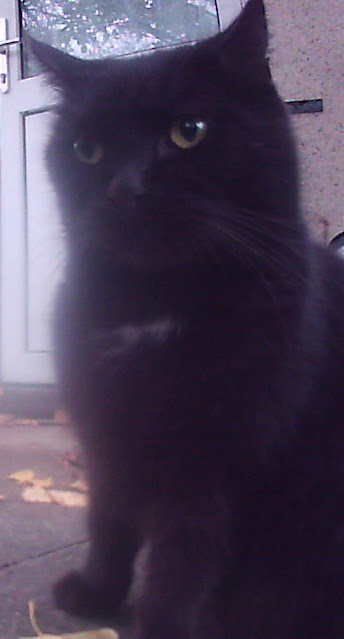I started the Wildcat and Ferals Study in 1980. One of the things I knew was that there were a lot of feral cats around, I also knew, growing up in the 1960s in St Werburgh's, Bristol, that every shop along Mina Road from Claude's Hardware, Jarman's the newsagents, the post office and Pople's Popular pies had shop cats.
The duty of the shop cat was to keep down mice and any rat but they also ate cockroaches, beetles and more. They were fed but not overfed as cats are today. Overfed meant the cat was not hungryenough to catch and kill the pesties,
Since that time I have owned 8 rescue cats (indoor) at one time four along with three large dogs. I watched them put dogs 5 times their size in their place; hunt, stalk moths, spiders and other insects to kill and eat and studied everything from ear, whisker, tail and slight body movements.
I have also been able to make the acquaintance of domestic cats that normally do not like strangers -it takes a lot of effort on my part but it's worth it. Strays have also allowed me to associate with them. I have an album of various cats including "Grey" who I first met when he moved into the area and growled at me and prepared to charge me -I won and after that we got on pretty well to the point that he'd let me check his bettle scars.
By observation and cameras I have found that mice are killed. The occasional -rare thankfully compared to a few years ago- rat. I got a collared dove from one who is a born huntress but it was later killed by a sparrowhawk. The semi feral that now lives next door has caught a couple of pigeons and taken them into the neighbours home alive and they were then released. The same cat also took in live mice. Again, same cat found and played with but did not harm slow worms (anyone not familiar with these they are legless lizards).
With the number of cats passing through the property the "devastation" of wildlife some blame cats for is not happening. Eleven houses in this block and no large number of mammals and birds killed. The semi feral does tease foxes and at one point leapt onto a fox's back to bite and twist the nape of its neck but the neighbour rescued the fox.
There are examples of paler, greyer coloured wildcats and these are NOT feral domestics seen by Mr Nobby on a walk. These have been observed, killed and identified after examination by noted naturalists who were familiar with all the 'vermin'. Feral domestics were identified and shot and of no interest.
So, what I have learnt is that the Museum Specimen type is even lucky to have continued existing to 2022. For the look they had was what museums wanted and I was told this many years ago by the late Arthur Cadman and other naturalists. There are anecdotes about wildcats shot up in Scotland being sent to Museums in England where they were rejected and sent back because it was not the type. And if their museum did not have the type they considered, in the snobbish way Victorian and Edwardian museum curators did, that they would be considered "not that good". That was not on. So Museum Specimen type or nothing!
Look at the photos below which took a few weeks to take using hidden cameras -a wildcat and "Kellas" cat (wildcat-domestic hybrid). What do you think?
At one point I had four trail cams out covering the area and some of these were left running but a back yard was found where the male and female had a "mousing" spot
Below: after a while knocking over the camera got boring for the female and I found placing the camera in foliage by the "mousing" spot worked -you can just about see the inverted triangle on her chest.














No comments:
Post a Comment